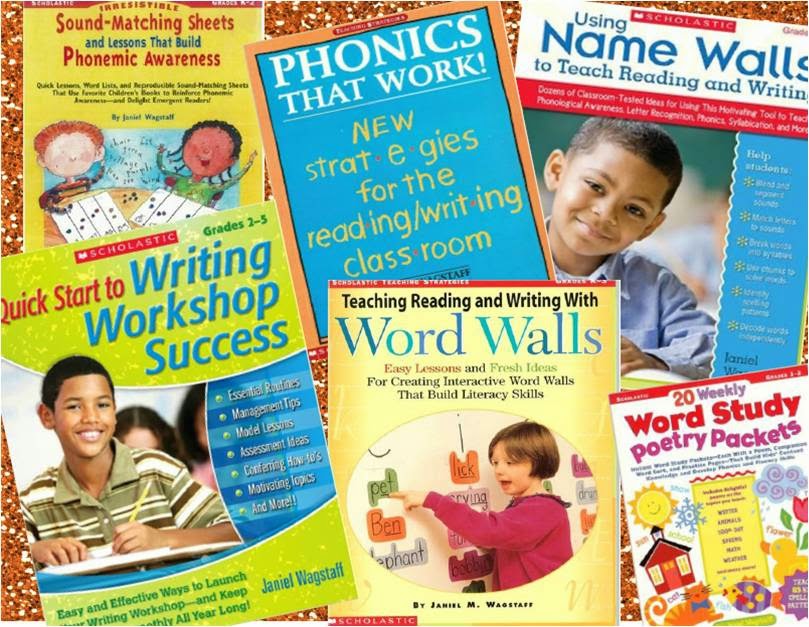This was the first book I wrote on the topic, published in 1994! I never thought I'd write again--it was such a difficult task. But, it was well worth it. The book showed how to use chunking as a decoding and spelling strategy across varied authentic reading and writing contexts along with integrating the use of a kid-friendly, relevant Word Wall containing key words for the chunks. (This was before 'chunking,' 'decoding by analogy,' or using phonograms had become so popular--nowadays 'chunking' is part of every core reading program!) If you're not already well-versed on this research-based, highly effective strategy, you can still grab this bad-baby on Amazon for a whopping 1 CENT! Ha..gotta' love that. http://www.amazon.com/Phonics-Strategies-Reading-Writing-Classroom/dp/0590496247/ref=sr_1_1?ie=UTF8&qid=1435119474&sr=8-1&keywords=phonics+that+work
Even though I thought I'd never write again, LO! Here's another title (from 1999) emphasizing the explicit teaching of phonics along with guiding the work in real reading and writing contexts. Again, chunking is emphasized, as is the use of Word Walls for reinforcement and scaffolding learners. But for grades K-1, I also included the idea of using key words to draw analogies while reading and writing unknown words using an ABC Wall.
This work was accompanied by teacher-training videos from my Kinder, 1st and 2nd grade classrooms (produced by BER--the Bureau of Education and Research). Some video snippets can be seen here...https://www.youtube.com/watch?v=92k93lnQMvE and https://www.youtube.com/watch?v=BAnoy3Ox8ao
Wait...there's more... Fun with Phonemic Awareness! I was teaching kindergarten and found a way to maximize time by integrating hands-on work with sounds with favorite childrens' books. Thus...
See the kiddos in the cover picture? They're matching sounds they isolate with sounds from some characters from the classic: Brown Bear, Brown Bear by Bill Martin Jr. and Eric Carle. Below: a blank 'sound board' for matching beginning sounds, ending sounds, vowel sounds, rhyming words, etc. with key elements from Laura Numeroff's If You Give a Mouse a Cookie!
 | |||||
| Some of my students matching sounds on 'sound boards.' This game-like activity is one of their favorite ways to practice phonemic awareness! |
Let's see how long I can stay coherent! Okay, next:
For me, the purpose is always skill and strategy building within authentic literacy contexts. After all, everything we do should feed students' love of reading and writing! Here, the focus is poetry. Poetry is so engaging to students! So, I wrote a few little ditties to use across the curriculum for shared reading and building fluency through rereads. PLUS, the emphasis is on using the poems to harvest words with high frequency chunks for building automaticity and strategic use! LOVE POETRY as a context for learning phonics...
2009 brought:
Even Marilyn Jager Adams told me this book was great! (Which was a highlight of my existence on Earth!) Well, it ought to be after researching and developing methods for effective phonemic awareness and phonics instruction for 20 years! The big contributions here include the idea of jump-starting instruction using the words that mean the most to students: their names! I show how to use names for phonemic awareness and phonics instruction across grade levels (K-3) and skill-levels, and, again, focus on strategic thinking and using Word Walls across literacy contexts. I developed a ton of different concrete models for helping students manipulate sounds and detailed their use in the book. Here are two posts from my other blog about one of the ideas--kids love these and they really help them understand how sounds work in words!:
http://janielwagstaff.blogspot.com/2012/04/what-can-you-do-with-elastic-waistband.html and
http://janielwagstaff.blogspot.com/2012/04/elastic-band-models-pa-practice-for.html
Here's a close-up of a Chunking Name Wall (with additional words added as the Wall builds beyond the names of students in your classroom):
Here's a close-up of an ABC name wall for K-1 (we fill in the 'holes' for letter-sounds we don't have among our students' names with key words from favorite poems and books).
 |
| And, here are a few other concrete models not mentioned in the blog posts I linked to above. |

Here's the link to the video:
https://www.facebook.com/151194691600505/videos/2282635981240/?permPage=1
 |
| A picture snipped from the video: I'm giving specific, immediate feedback on a student's spelling attempt using key words from our Word Wall. |
That's it for me...for now! Check-out the other bloggers who have linked up this week for more FUN phonemic awareness and phonics ideas! Also, if you have an idea, link up below! Happy Blogging!

























